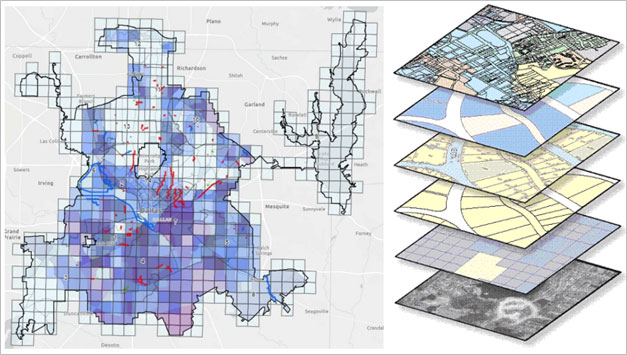Over the last several years, inflation has resulted in a sharp increase in the cost of construction and a quick review of scholarly and non-scholarly articles reveals that the effects of inflation on the cost of infrastructure is a global challenge. Through the lens of local government, given the finite resources available, an ever-increasing demand for enhanced infrastructure, and the rising cost of construction, when deliberating on the selection of where to invest its construction dollars, municipal leaders must consider multiple data points to ensure efficiency and the highest possible return on investment. Understanding the importance placed on the selection of construction projects, this article will detail how the City of Dallas has used and is using the convergence of data to drive decisions in infrastructure investments.
Recent Data-Driven Infrastructure Projects
Streetlight Priority Zones
In 2019, the City of Dallas’ Department of Transportation (DDOT) evaluated several cross-departmental priorities to drive where to invest in light-emitting diode (LED) streetlighting. Whereas streetlights can affect crime rates, vehicular and pedestrian accidents, economic development, and quality of life, DDOT used data and geographic information system (GIS) spatial analysis to overlay Racially and Ethnically Concentrated Areas of Poverty (RECAP) Zones, market value analysis, housing reinvestment areas, and target area action grids (crime data) to create target locations for streetlight investments.
Streetlight Community Wireless High-Speed Internet (Wi-Fi) Pilot Projects
Evolving from the Streetlight Priority Zones, in 2020, multiple City of Dallas departments began evaluating how to address the digital divide or those households with low access to the internet. Through GIS spatial analysis, City of Dallas teams identified ten neighborhoods that were in the streetlight priority zones, had low access to the internet, and were near City of Dallas facilities such as recreation centers or fire stations. The City of Dallas cross-departmental team installed streetlights within the ten neighborhoods, installed Wi-Fi equipment on those streetlights, and installed telecommunications fiber from the adjacent City facilities to the Wi-Fi equipment on the streetlights. The Streetlight Community Wi-Fi Pilot Projects not only addressed the needs included in the Streetlight Priority Zones but also provided community Wi-Fi to approximately 320 homes that data showed were lacking access to the internet.
Red Cloud Neighborhood Smart Cities Pilot Project
Building on the success of the Community Wi-Fi Pilot Projects, in late 2021, the City of Dallas took its lessons learned to another level with the Red Cloud Neighborhood Smart Cities Project. Following the same data analysis used to identify Streetlight Priority Zones and lack of access to the internet, the City of Dallas team also evaluated the conditions of the infrastructure in the Red Cloud Neighborhood to develop a comprehensive project to reconstruct all of the neighborhood’s streets, alleys, and sidewalks, while installing new streetlights for community Wi-Fi, a number of artificial intelligence (AI)-enabled cameras, and environmental monitors. The Red Cloud Neighborhood Smart Cities Pilot Project, which won a Smart 50, Smart Cities award in 2023, used data to drive the infrastructure, lighting, and smart cities technology investments to bring community Wi-Fi to 190 homes and the quality of life for the residents of the Red Cloud Neighborhood.
Convergence of Data for Developing a 2024 Bond Program
Understanding how the City of Dallas has used data to drive infrastructure investments, City teams are currently working on how to infuse data in the development of an approximate $1B, 2024 Bond Program. While there are approximately $16B in infrastructure and facility needs, City of Dallas teams have developed a data-driven framework to prioritize the $16B in needs to fit within the approximate $1B of available funding.
Priority GIS Overlays
Historically, for allocating street construction dollars, the City of Dallas has programmed capital construction projects in its bond programs through a combination of equal distribution for each City Council District and then an allotment based upon condition, or technical scoring, of the streets. In the 2024 Bond Program development, City teams are evaluating not only technical scores of projects, but other project scoring priority variables or data including:
- Equity,
- High Crime Areas,
- Proximity to Transit Oriented Development,
- Market Value Analysis,
- 311 Customer Service Requests,
- Project Intersection with Another Project (to gain economies of scale in construction).
Using the project scoring variables listed above, the City of Dallas team has developed a grid map (shown below) to guide staff and stakeholders to the locations of the most-impactful projects. Through GIS spatial analysis, projects are not only scored based upon technical scores (up to 80 points) but through additional points (up to 20) based upon the Priority GIS Overlays.
GIS Priority Overlay Map
(Darker Grids Indicate Higher Priority Areas Based Upon Overlapping Priority Variables; Red Lines/Points indicate water infrastructure projects)
 Summary
Summary
As many municipalities are facing similar infrastructure needs, funding challenges, and competing priorities, leaders must use data to make objective infrastructure investment decisions. While quantitative and GIS-based analysis may not lead to ultimate decisions for infrastructure investments, they are effective tools that can be used to narrow down vast amounts of data and identify priorities. However, in a push to be a data-driven organization, recent and current examples highlighted in this article show how data drives infrastructure investment decisions in the City of Dallas.
Biography
Dr. Robert M. Perez serves as Assistant City Manager for the City of Dallas and has gained over 22 years of public sector experience while working for the City of San Antonio and the City of Dallas. Prior to being appointed as Assistant City Manager, Robert served as the City of Dallas’ Director and Assistant Director of Public Works. Before joining the City of Dallas, Robert worked for the City of San Antonio for 16 years in leadership positions and other capacities within the departments of Public Works, the Office of Management and Budget, the San Antonio Metropolitan Health District, and Community Initiatives.













